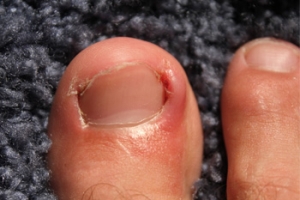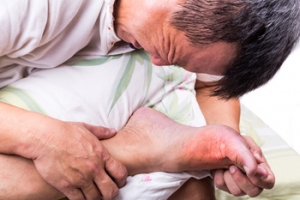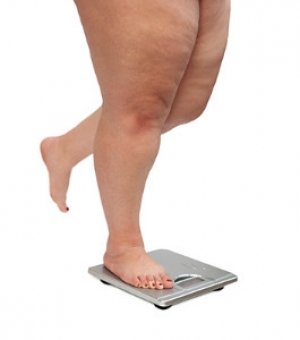
Plantar Fasciitis
The plantar fascia is a connective tissue in the heel that stretches across the bottom length of your foot. Plantar fasciitis occurs when the connective tissue becomes inflamed, causing heel pain and discomfort during physical activity. Although the condition is completely treatable, traditional methods can take up to a year to start becoming effective.
Plantar fasciitis is caused by a number of everyday activities, so understanding the condition is important for managing and treating it. One of the most common causes of plantar fasciitis is excessive running, especially with improper fitting or non-supportive shoes. Too much exercise can lead to the plantar fascia being overworked and overstretched, which can cause tears in the tissue. Along with improper fitting shoes, pronation, the rolling of the feet inward, is a common cause of plantar fasciitis. If not treated properly, the plantar fascia becomes overstretched and starts to tear, causing inflammation.
Despite the common causes of plantar fasciitis, there are many different treatment options. For less severe cases, conservative home remedies include taking anti-inflammatory drugs to alleviate pain, applying ice packs to the bottom of your foot and heel, slowly stretching and exercising your feet to re-strengthen the tissue, and using orthotic devices are all ways to help manage your plantar fasciitis.
For more severe cases, shockwave therapy has become a common solution for plantar fasciitis. Shockwave therapy can effectively break up the tissue on the bottom of your foot which facilitates healing and regeneration. This fights the chronic pain caused by plantar fasciitis. Even if this doesn’t work, surgery is always a final option. Surgery on the tissue itself can be done to permanently correct the issue and stop the inflammation and pain in your heels.
No matter what the case may be, consulting your podiatrist is the first and best step to recovery. Even the slightest amount of heel pain could be the first stage of plantar fasciitis. Untreated symptoms can lead to the tearing and overstretching of tissue. Because the tearing of tissue can be compounded if it remains ignored, it can evolve into a severe case. The solution is early detection and early treatment. Talk to your podiatrist about the possibilities of plantar fasciitis if you’re experiencing heel pain.
What Causes Ingrown Toenails?
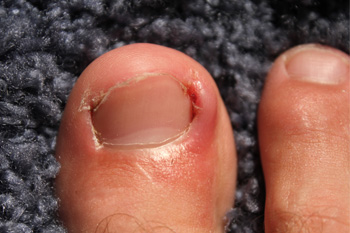 Patients who experience ingrown toenails are often familiar with the pain and discomfort they cause. They occur as a result of toenails that grow into the surrounding skin, and this may cause an infection. Some of the symptoms that are associated with this condition can include extreme tenderness around the affected area, and a discharge that may ooze from the nail. This ailment is caused by trimming the toenails improperly, and wearing shoes and socks that are too tight. There are effective treatment methods that can be implemented which include removing a portion of the nail, and draining any infection that is present. It is possible to avoid getting ingrown toenails by wearing shoes that fit properly, and trimming the toenails straight across the toe. If you have developed this condition, please consult with a podiatrist who can offer proper treatment advice.
Patients who experience ingrown toenails are often familiar with the pain and discomfort they cause. They occur as a result of toenails that grow into the surrounding skin, and this may cause an infection. Some of the symptoms that are associated with this condition can include extreme tenderness around the affected area, and a discharge that may ooze from the nail. This ailment is caused by trimming the toenails improperly, and wearing shoes and socks that are too tight. There are effective treatment methods that can be implemented which include removing a portion of the nail, and draining any infection that is present. It is possible to avoid getting ingrown toenails by wearing shoes that fit properly, and trimming the toenails straight across the toe. If you have developed this condition, please consult with a podiatrist who can offer proper treatment advice.
Ingrown toenails can become painful if they are not treated properly. For more information about ingrown toenails, contact Dr. James Kutchback of James Kutchback, DPM, ABLES, CWS-P. Our doctor can provide the care you need to keep you pain-free and on your feet.
Ingrown Toenails
Ingrown toenails occur when a toenail grows sideways into the bed of the nail, causing pain, swelling, and possibly infection.
Causes
- Bacterial infections
- Improper nail cutting such as cutting it too short or not straight across
- Trauma to the toe, such as stubbing, which causes the nail to grow back irregularly
- Ill-fitting shoes that bunch the toes too close together
- Genetic predisposition
Prevention
Because ingrown toenails are not something found outside of shoe-wearing cultures, going barefoot as often as possible will decrease the likeliness of developing ingrown toenails. Wearing proper fitting shoes and using proper cutting techniques will also help decrease your risk of developing ingrown toenails.
Treatment
Ingrown toenails are a very treatable foot condition. In minor cases, soaking the affected area in salt or antibacterial soaps will not only help with the ingrown nail itself, but also help prevent any infections from occurring. In more severe cases, surgery is an option. In either case, speaking to your podiatrist about this condition will help you get a better understanding of specific treatment options that are right for you.
If you have any questions please feel free to contact our offices located in The Woodlands and Woodville, TX . We offer the newest diagnostic and treatment technologies for all your foot and ankle needs.
Ingrown Toenails
An ingrown toenail is a nail that has curved downward and grown into the skin. This typically occurs at either the nail borders or the sides of the nail. As a result, pain, redness, swelling, and warmth may occur in the toe. If a break in the skin forms due to the ingrown nail, bacteria may enter and cause an infection in the area; this is typically characterized by a foul odor and drainage.
Ingrown toenails have multiple reasons for developing. In many instances, the condition is a result of genetics and is inherited. The most common cause, however, is improper trimming; cutting the toenails too short forces the skin beside the nail to fold over. An ingrown toenail can also develop due to trauma, such as stubbing the toe, having an object fall on the toe, or participating in activities that involve repeated kicking or running. Wearing shoes that are too tight or too short can also cause ingrown toenails.
Treatment for an ingrown toenail varies between patients and the severity of the condition. In most cases, it is best to see your podiatrist for thorough and proper treatment. After examining your toe, your podiatrist may prescribe oral antibiotics to clear the infection if one is present. Surgical removal of either a portion of the nail or the entire nail may also be considered. In some cases, complete removal or destruction of the nail root may be required. Most patients who undergo nail surgery experience minimal pain afterward and can return to normal activity the following day.
Ingrown toenails can be prevented with proper nail trimming and by avoiding improper-fitting shoes. When cutting the toenails, be sure that you are cutting in a straight line and avoid cutting them too short. Shoes should not be too short or tight in the toe box.
What Causes Gout Attacks?
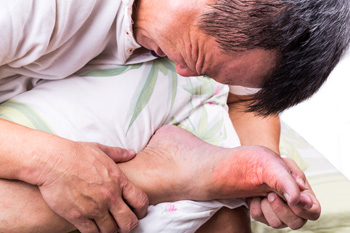 The symptoms that are associated with gout often involve severe pain located at the base of the big toe. If a gout attack suddenly occurs, it may last for several weeks, and it may not develop again for a significant amount of time. The affected area is typically swollen and can feel sensitive when touched. Gout is a result of elevated uric acid levels in the bloodstream and is produced by eating foods that are high in purine levels. These types of foods include red meat, shellfish, and alcohol, if consumed in large amounts. Some patients may have existing medical conditions that can play a significant role in developing gout. These can include diabetes, high blood pressure, or poor kidney function. Research has shown that there are measures that can be implemented to potentially prevent gout attacks. Maintaining a regular exercise regime and incorporating healthy eating habits into your life can help limit painful gout attacks. If you are afflicted with this ailment, it is advised that you seek the counsel of a podiatrist who can properly treat gout.
The symptoms that are associated with gout often involve severe pain located at the base of the big toe. If a gout attack suddenly occurs, it may last for several weeks, and it may not develop again for a significant amount of time. The affected area is typically swollen and can feel sensitive when touched. Gout is a result of elevated uric acid levels in the bloodstream and is produced by eating foods that are high in purine levels. These types of foods include red meat, shellfish, and alcohol, if consumed in large amounts. Some patients may have existing medical conditions that can play a significant role in developing gout. These can include diabetes, high blood pressure, or poor kidney function. Research has shown that there are measures that can be implemented to potentially prevent gout attacks. Maintaining a regular exercise regime and incorporating healthy eating habits into your life can help limit painful gout attacks. If you are afflicted with this ailment, it is advised that you seek the counsel of a podiatrist who can properly treat gout.
Gout is a foot condition that requires certain treatment and care. If you are seeking treatment, contact Dr. James Kutchback from James Kutchback, DPM, ABLES, CWS-P. Our doctor will treat your foot and ankle needs.
What Is Gout?
Gout is a type of arthritis caused by a buildup of uric acid in the bloodstream. It often develops in the foot, especially the big toe area, although it can manifest in other parts of the body as well. Gout can make walking and standing very painful and is especially common in diabetics and the obese.
People typically get gout because of a poor diet. Genetic predisposition is also a factor. The children of parents who have had gout frequently have a chance of developing it themselves.
Gout can easily be identified by redness and inflammation of the big toe and the surrounding areas of the foot. Other symptoms include extreme fatigue, joint pain, and running high fevers. Sometimes corticosteroid drugs can be prescribed to treat gout, but the best way to combat this disease is to get more exercise and eat a better diet.
If you have any questions please feel free to contact our offices located in The Woodlands and Woodville, TX . We offer the newest diagnostic and treatment technologies for all your foot and ankle needs.
Gout
Gout is a form of arthritis that is caused by a buildup of uric acid crystals in the joints. This considered to be one of the most frequently recorded medical illnesses throughout history. Gout occurrences in the US have risen within the past twenty years and the condition now affects 8.3 million people which is 4% of all Americans. Researchers have found that gout affects men more than women and African-American men more than white men.
Symptoms of gout are warmth, swelling, discoloration, and tenderness in the affected joint area. The small joint on the big toe is the most common place for a gout attack to occur.
People who are obese, gain weight excessively, drink alcohol heavily, have high blood pressure, or have abnormal kidney function are more likely to develop gout. Furthermore, certain drugs and diseases are likely to increase levels of uric acid in the joints which eventually leads to gout. You are also more likely to develop gout if you eat a lot of meat and fish.
Many who experience gout attacks will experience repeated attacks over the years. Some people who have gout symptoms, may never have them again, but others may experience them several times a year. If you have gout symptoms throughout the year, you may have recurrent gout. Those who have gout should also be careful about their urate crystals collecting in their urinary tract, because this may lead to kidney stones.
Diagnosis for gout is done by checking the level of uric acid in the joints and blood. Your podiatrist may also prescribe medicine to reduce uric acid buildup in the blood, which will help prevent any gout attacks.
To treat gout, your podiatrist may also prescribe you Anti-inflammatory medication (NSAIDs) which will relieve the pain and swelling of a gout episode and it can also shorten a gout attack. Maintaining a healthy diet is also a proven method to prevent gout attacks.
Types of Foot Therapy
 Patients who have foot pain can benefit from different types of foot therapy. When the feet are soaked in warm water, mild relief may be found. This is helpful in relaxing sore foot muscles. Additionally, having foot massages performed can aid in reducing tension in the body, improving circulation, and may ease any pain that is present. When the toes are spread apart, the muscles that lie underneath are stretched, and this may help to strengthen the entire foot. There are some patients who find it beneficial to use topical treatments which include eucalyptus oil.This provides a different sensation, and may help in relieving existing foot pain. If you would like to learn of additional types of foot therapy, it is advised to schedule a consultation with a podiatrist who can properly guide you.
Patients who have foot pain can benefit from different types of foot therapy. When the feet are soaked in warm water, mild relief may be found. This is helpful in relaxing sore foot muscles. Additionally, having foot massages performed can aid in reducing tension in the body, improving circulation, and may ease any pain that is present. When the toes are spread apart, the muscles that lie underneath are stretched, and this may help to strengthen the entire foot. There are some patients who find it beneficial to use topical treatments which include eucalyptus oil.This provides a different sensation, and may help in relieving existing foot pain. If you would like to learn of additional types of foot therapy, it is advised to schedule a consultation with a podiatrist who can properly guide you.
Foot therapy is often necessary for those recovering from either foot deformities or foot injuries. If you have concerns regarding therapy, consult with Dr. James Kutchback from James Kutchback, DPM, ABLES, CWS-P. Our doctor can provide the care you need to keep you pain-free and on your feet.
Most Common Injuries
People who are active or athletes are prone to a variety of injuries. Therefore, it is often important to take part in physical therapy in order to quickly get back on the right track.
What to Do When Injured
Physical Therapy – This specialized treatment will focus on the affected area, speeding up recovery and the overall healing process. It is a proven method that has helped millions of people return from any injury.
During physical therapy you will undergo regimented training to get back into full form. Training is often very difficult, especially at first when the foot feels weak. Physical therapy often involves:
Basic stretching and twisting exercises – getting the feet’s mobility and flexibility up.
Massaging – the therapist will massage the injured area in order to activate the muscles and relax them.
Strengthening Exercises – this allows the muscles in the affected area to regain their full strength, a vital step towards full recovery.
If you have any questions please feel free to contact our offices located in The Woodlands and Woodville, TX . We offer the newest diagnostic tools and technology to treat your foot and ankle needs.
Foot Therapy for Sports Injuries
Whether in practice or in the game, athletes put their bodies through great stress. Some sports demand more from the body than others. However, every sport has an element of inorganic movement or unnatural motion. For example, in softball, a pitcher winds up and flings her body with an incredible amount of dexterity in order to get the most ideal velocity out of her pitches. This motion, incredibly taxing on the body, can cause serious injury.
One of the most common issues of athletic injuries happens in the feet. If it’s a damaging fracture that leaves the athlete sidelined or just a simple turf toe, foot injuries can still be very frustrating and painful. Regardless of the sport, athletes still require use of their feet in some fashion. This is why foot therapy is extremely vital for getting athletes back on the right track to return to the field.
No matter the injury, the best way to speed up the recovery period is to receive physical therapy. Physical therapy has proven to work for millions of people. Professional physical therapists are specifically trained to help people return to proper form from any injury.
During physical therapy, you will go through organized training in order to get back into form. Sometimes training can be quite difficult, especially in the beginning when there is more pain and the foot feels awkward. To alleviate this, you will do basic twisting and stretching exercises in order to get flexibility and foot mobility back up. The therapist will also massage the injured area to activate and relax muscles. Over time you will eventually move up to strengthening exercises, designed specifically so that the injured area is exercised.
Foot therapy for sports is a modern science miracle. Unlike other treatments that may employ the use of fancy chemicals and terminology, physical therapy is an evidence-based practice that offers the same benefits. Due to huge advancements in the knowledge of muscles and joints, doctors can turn catastrophic injuries around so that athletes can return to the game once more.
Obesity and Plantar Fasciitis
 Obesity may cause pain in the majority of the foot. This is caused by extra weight the feet endure while daily activities are being performed. Many patients who are overweight notice they have heel pain, and this can lead to a condition this is known as plantar fasciitis. This is a result of a tear in the plantar fascia, which connects the heel to the toes. Relief is typically found if additional weight is lost, and when a mild exercise routine is frequently practiced. Many obese patients find it difficult to implement stretching and exercise techniques, and this is often because of the added weight that is carried around. If you are overweight and have foot pain, please speak with a podiatrist who can guide you toward implementing healthy lifestyle habits.
Obesity may cause pain in the majority of the foot. This is caused by extra weight the feet endure while daily activities are being performed. Many patients who are overweight notice they have heel pain, and this can lead to a condition this is known as plantar fasciitis. This is a result of a tear in the plantar fascia, which connects the heel to the toes. Relief is typically found if additional weight is lost, and when a mild exercise routine is frequently practiced. Many obese patients find it difficult to implement stretching and exercise techniques, and this is often because of the added weight that is carried around. If you are overweight and have foot pain, please speak with a podiatrist who can guide you toward implementing healthy lifestyle habits.
Obesity has become very problematic at this point in time and can have extremely negative effects on the feet. If you’re an obese individual and are concerned about your feet, contact Dr. James Kutchback from James Kutchback, DPM, ABLES, CWS-P. Our doctor can provide the care you need to keep you pain-free and on your feet.
Obesity and Your Feet
Since your feet are what support your entire weight when standing, any additional weight can result in pain and swelling. Being overweight is one of the main contributors to foot complications.
Problems & Complications
Extra Weight – Even putting on just a few extra pounds could create serious complications for your feet. As your weight increases, your balance and body will shift, creating new stresses on your feet. This uneven weight distribution can cause pain, even while doing the simplest tasks, such as walking.
Diabetes – People who are overweight are at serious risk of developing type-2 diabetes, which has a drastic impact on the health of your feet. As you get older, your diabetes might worsen, which could lead to loss of feeling in your feet, sores, and bruises. You could also become more prone to various infections.
Plantar fasciitis – Pressure and stress that is placed on muscles, joints, and tendons can trigger plantar fasciitis, which is an inflammation of tissue that forms along the bottom of the foot.
If you have any questions please feel free to contact our offices located in The Woodlands and Woodville, TX . We offer the newest diagnostic and treatment technologies for all your foot and ankle needs.






